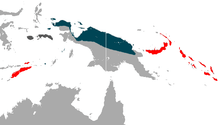Northern common cuscus
| Northern common cuscus[1] | |
|---|---|
| | |
| Scientific classification | |
| Kingdom: | Animalia |
| Phylum: | Chordata |
| Class: | Mammalia |
| Order: | Diprotodontia |
| Family: | Phalangeridae |
| Genus: | Phalanger |
| Species: | P. orientalis |
| Binomial name | |
| Phalanger orientalis (Pallas, 1766) | |
 | |
| Northern common cuscus range (blue — native, red — introduced, dark gray — origin uncertain) | |
The northern common cuscus (Phalanger orientalis), also known as the grey cuscus, is a species of marsupial in the family Phalangeridae native to northern New Guinea and adjacent smaller islands, but is now also found in the Bismarck Archipelago, south-east and central Moluccas, the Solomons and Timor, where it is believed to have been introduced in prehistoric times.[2] It was formerly considered conspecific with the allopatric P. intercastellanus and P. mimicus.
Habitat
The northern common cuscus normally inhabits disturbed habitats. These would include secondary forest, plantations, and gardens. This species is also found in primary tropical forest.[3] While living in the arboreal environments, hunters in the area believe that the tree hollows are the preferred den site of the cuscus.[4]
The Northern common cuscus inhabits the islands of Timor, specifically Indonesia and Timor Leste, Wetar and Leti (both to Indonesia) through the Kai Islands and a number of the Moluccan Islands of Indonesia (including: Ambon, Buru, and Seram); it is also found on the islands of Misool, Waigeo, Batanta, and Salawati (all Indonesia), and ranges over much of the northern part of the island of New Guinea (Indonesia and Papua New Guinea), including a number of offshore islands.[3] It ranges as far east as the Bismarck Archipelago, Papua New Guinea, where it is present on many islands including the islands of New Britain and New Ireland. It also occurs on many of the Solomon Islands.[3] It is believed that many of the insular island populations are the result of prehistorical introductions, possibly including: Timor, Seram, Buru, Sanana, the Kai Islands, the Bismarck Archipelago, and the Solomon Island chain.[3] Local villagers in the above-mentioned countries and regions reported that the northern common cuscus can be found in any substantially forested areas from coastal monsoon rainforest and gallery forest to remnant montane rainforest.[5]
Niche
Generally, its niche is thought to be that of a nocturnal arboreal folivore with frugivorous tendencies.[6] [7] [8]
References
| Wikispecies has information related to: Phalanger orientalis |
| Wikimedia Commons has media related to Phalanger orientalis. |
- ↑ Groves, C.P. (2005). Wilson, D.E.; Reeder, D.M., eds. Mammal Species of the World: A Taxonomic and Geographic Reference (3rd ed.). Baltimore: Johns Hopkins University Press. p. 47. OCLC 62265494. ISBN 0-801-88221-4.
- 1 2 Leary, T.; Singadan, R.; Menzies, J.; Helgen, K.; Wright, D.; Allison, A.; Hamilton, S.; Salas, L. & Dickman, C. (2008). "Phalanger orientalis". IUCN Red List of Threatened Species. Version 2008. International Union for Conservation of Nature. Retrieved 28 December 2008.
- 1 2 3 4 Leary, T., Singadan, R., Menzies, J., Helgen, K., Wright, D., Allison, A., Hamilton, S., Salas, L. & Dickman, C. 2008. Phalanger orientalis. In: IUCN 2013. IUCN Red List of Threatened Species. Version 2013.2. <www.iucnredlist.org>.
- ↑ TE Heinsohn, Department of Archaeology and Natural History, Research School of Pacific and Asian Studies, Australian National University, ACT 0200, Australia. Manuscript received 1 September 2004; accepted 23 October 2004.
- ↑ TE Heinsohn, Department of Archaeology and Natural History, Research School of Pacific and Asian Studies, Australian National University, ACT 0200, Australia. Manuscript received 1 September 2004; accepted 23 October 2004.
- ↑ FLANNERY TF, 1994. Possums of the world: a monograph of the Phalangeroidea. GeoProductions / Australian Museum: Sydney.
- ↑ FLANNERY TF, 1995a. Mammals of New Guinea. Australian Museum / Reed Books: Sydney.
- ↑ FLANNERY TF, 1995b. Mammals of the south-west Pacific and Moluccan Islands. Australian Museum / Reed Books: Sydney.
